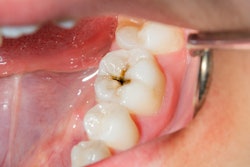
Prenatal fluoride exposure may be linked to increased birth size, as well as higher odds of infants being born large for their gestational age, according to a large Swedish study published on August 20 in Environmental Research.
The study of more than 500 mother-child pairs is the first to suggest a correlation between gestational fluoride exposure and birth size, the authors wrote. The findings can't be explained by the water source or by food consumed during pregnancy except for tea and fruit, which had weak but significant relationships with infant birth weight and may be associated with the additional water consumption, according to the authors.
"Our findings highlight the need for further research on the possible adverse effects of early-life fluoride exposure on child development and health," wrote the authors, led by Maria Kippler, PhD, of the Karolinska Institute in Stockholm.
For years, fluoride has been added to oral care products and community water supplies to help prevent tooth decay. In recent years, some researchers have raised concerns that consuming fluoride could have negative effects on children's development.
Recent studies have suggested a relationship between kidney function in adolescents and fluoride levels in community drinking water as well as a potential link between maternal fluoride exposure and lower IQ and nonverbal deficits in kids.
Additionally, large gestational-age babies can cause complications for mother and child. Babies with birth weights greater than the 90th percentile for their gestational age can result in difficult deliveries, birth injuries, and an increased incidence of birth defects.
To evaluate the impact of gestational fluoride exposure on birth outcomes, researchers analyzed data from 558 mothers and their children who participated in the NICE (Nutritional Impact on the Immunological Maturation During Childhood in Relation to the Environment) birth cohort study. NICE consists of families in northern Sweden recruited between 2015 and 2018. The study was funded by the Swedish Research Council Formas; the Swedish Research Council; the Swedish Research Council for Health, Working Life and Welfare; the Västra Götaland Region; the Research and Learning Unit at Region Norrbotten; and the Karolinska Institute.
An ion selective electrode measured maternal fluoride exposure by assessing urine concentration, a known marker of ongoing exposure, at the 29th week of pregnancy. The infants' weight, length, head circumference, and gestational age at birth were extracted from hospital records.
The mean birth length was 50 cm (about 19.6 inches) for girls and 50.7 cm (about 19.9 inches) (SD = 2.4) for boys. The mean head circumference was 34.6 cm (about 13.6 inches) for girls and 35.3 cm (about 13.8 inches) for boys, and the mean birth weight was 3,530 g (about 7.7 lb) for girls and 3,640 g (about 8 lb) for boys, according to the study.
The median urinary fluoride concentration was 0.71 mg/L (5th-95th percentile 0.31-1.9 mg/L; specific gravity adjusted). Multivariable-adjusted regression models showed that every 1 mg/L increase of maternal urinary fluoride correlated with a mean increase in birth weight by 84 g (about 2.9 oz), length by 0.41 cm (about 0.16 inches), and head circumference by 0.3 cm (about 0.11 inches), the authors wrote.
Of the children, 77 (28%) were born large for the gestational age (90th percentile). Regression models revealed that every 1 mg/L increase of maternal urinary fluoride was linked to increased odds of being born large for the gestational age (odds ratio = 1.39), they wrote.
Drinking tea, particularly black tea, was associated with an increase in urinary fluoride concentration among the mothers. Fluoride concentration was also higher in the winter and fall samples, likely because more tea is consumed when the weather is cooler.
"Urinary fluoride concentrations were not correlated with the food intake data, apart from a weak positive correlation with tea, which may be the result of the additional water consumption and of the tea intake itself," the authors wrote. "Black, followed by green, tea is known to contain more fluoride than other tea items."
Notably, the median fluoride level of the more than 500 mothers was below the 1.5 mg/L limit recommended by the World Health Organization to prevent fluorosis. The study's authors also noted that they controlled for "well-established determinants of increased size at birth."
Nevertheless, the researchers noted several limitations. While the authors had information about maternal obesity, they did not have data on the mothers' size at birth, which can influence infant birth weight. Further, only one spot urine sample was collected during late pregnancy to assess urinary fluoride concentrations. Although the concentrations were adjusted for specific gravity to account for variation in urine dilution, it may have resulted in exposure misclassification due to the way the body functions during late pregnancy, the authors wrote.
"Considering the ubiquity of fluoride in drinking water and that being born large for gestational age is linked with perinatal complications, additional prospective cohort studies are warranted to confirm our findings and to elucidate the mechanisms by which fluoride may affect intrauterine growth," Kippler et al wrote.




















